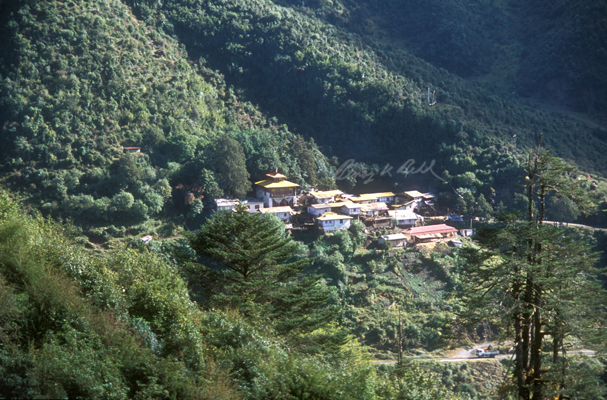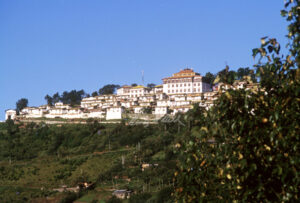Why is Arunachal Pradesh called the cradle of Buddhism

Ani Gompa, Tawang district of Arunachal Pradesh. Pic: Benoy Behl
Benoy K Behl
The Vajra or Thunderbolt symbolises the Buddhist philosophy which was developed at the universities of Nalanda, Vikramshila and Odantpuri. It was believed that the logic of this philosophy was as striking as a thunderbolt and as indestructible as a diamond. After Eastern India, the Buddhist centres of Kashmir and the North-East played an important role in the development of Vajrayana Buddhism.
Buddhist literature mentions four important centres of pilgrimage for devotees. Of these, Oddayana and Jalandhar are in the north-west of the Indian subcontinent and Kamarupa, present day Assam, is the centre in the east of India. Guru Padmasambhava who had studied at the Nalanda University in Bihar is known throughout the Himalayan regions as the Second Buddha. In the 8th century the great Guru swept right across the Himalayas, including Ladakh, Kinnaur, Lahaul-Spiti, Tibet all the way till Arunachal Pradesh spreading Buddhism everywhere. The holy relics of the Guru are believed to be enshrined in Hajo in Assam. This site is deeply revered by all Himalayan Buddhists.
At the Eastern end of his epic journey through the Himalayan regions the great Guru Padmasambhava brought Buddhism to Arunachal Pradesh in the 8th century. The Bhimkhar caves where the guru meditated are in the remote mountains at about 14,000 feet altitude. There are several places that he visited and there are marks and foot prints left by their master which are deeply revered by the people of Arunachal.

The Tak-tsang gompa or monastery is high in the mountains of Tawang district. Tak-Tsang means Tiger’s Den. The site was hallowed by the visit of Guru Padmasambhava. Arunachal Pradesh is among the few places where the original Nyigmapa sect of Buddhism which was established under Guru Padmasambhava continues till today.
The period of Guru Padmasambhava is known as the First Great Coming of Buddhism in the Himalayan and Trans Himalayan regions. In the distant mountains of Arunachal Pradesh the abode of clouds far from the clamor of the material world. The philosophy of Vajrayana Buddhism is nurtured and kept alive till today.
Attacks by Mongols wiped out the early Buddhist temples of Arunachal and the oldest Buddhist monument which survives today is the Gorsen Stupa, which was built in the 16th century. The silent vast majesty of this stupa awakens a deep sense of the divine. It is truly one of the great surviving stupas of India. In the 17th century, the great Tawang monastery which is one of the largest in existence today, was established at a strategic point connected by ancient routes.
Tawang remained in contact with the entire Buddhist region in the Eastern Himalayas and Tibet. The monastery belongs to the Gelugkpa sect which was founded at the end of the 14th century. Till today the monastery remains at a crossroads of culture and its mural paintings were recently remade by Buddhist painters from Bhutan. The Tawang monastery has long been famous for its great library of manuscripts. This is a vast collection which includes philosophical works, almanacs, books for the guidance of monks, record books of various monasteries, and other books. Along with the monastery at Tawang, a sister establishment of nuns, an Ani Gompa was set up on a nearby hill. In its seclusion, this nunnery preserves its gentle atmosphere and deeply religious traditions.
Prayer flags reflect the deep and simple believes of the people of the vast Himalayan regions. There are constant reminder of the compassionate philosophy and heritage of Buddhism. The masked Cham dance is the ultimate form of meditation of the Lamas. They pray and prepare themselves for many days before the dance. On the sacred ground it is not the lamas who are to dance but the deities themselves. By then, the lamas are to have entirely left behind their material concerns and their own personalities. They are to have become the deities.
The meditating monks perceive an inner reality, far more true than the illusion of the material world around. For the eternal moment of the Cham, earthly reality is suspended; desires and suffering forgotten, as the deities dance- blessing every being. This is the land made sacred by Guru Padmasambhava of the Nalanda university more than a thousand years ago. The search for the emancipation of the self continues here till today. It is the desire to rise above attachments and illusions of the material world.
Under the Glimpses of Culture series, India Habitat Centre presents an online talk and screening of the film Arunachal: Cradle of Buddhism produced by Benoy K Behl for Doordarshan on April 15, 6pm


